Dynamic Water Quality Changes in the Main Stream of the Yangtze River from Multi-Source Remote Sensing Data
Abstract
:1. Introduction
2. Materials and Methods
2.1. Study Area
2.2. Data
2.2.1. Remote Sensing Data
2.2.2. In-Situ Measurements
2.2.3. Other Data
2.3. Methods
2.3.1. Establishment of Models
2.3.2. Model Accuracy Verification
3. Results and Analysis
3.1. Single-Satellite Inversion
3.1.1. Establishment of Models from a Single Satellite
3.1.2. Accuracy Analysis
3.2. Multi-Source Satellite Inversion
3.2.1. Establishment of Models from Multi-Source Satellites
3.2.2. Accuracy Analysis
3.3. Spatial-Temporal Variations of Water Quality Parameters
3.3.1. Monthly and Annual Variations
3.3.2. Spatial Variations
3.3.3. Spatial-Temporal Variations of Water Quality
4. Factors and Discussion
4.1. Hydrological and Meteorological Factors
4.2. Human Factors
5. Conclusions
Author Contributions
Funding
Data Availability Statement
Acknowledgments
Conflicts of Interest
References
- Li, S.; Cheng, C.; Wang, X.; Li, Z. Analyzing regional economic disparities based on ESDA in Yangtze River Delta, China. In Proceedings of the 2015 IEEE International Geoscience and Remote Sensing Symposium (IGARSS), Milan, Italy, 26–31 July 2015; pp. 4530–4533. [Google Scholar]
- Xu, J.; Liu, R.; Ni, M.; Zhang, J.; Ji, Q.; Xiao, Z. Seasonal variations of water quality response to land use metrics at multi-spatial scales in the Yangtze River basin. Environ. Sci. Pollut. Res. 2021, 28, 37172–37181. [Google Scholar] [CrossRef] [PubMed]
- Yang, Z.; Wang, Y.; Shen, Z.; Niu, J.; Tang, Z. Distribution and speciation of heavy metals in sediments from the mainstream, tributaries, and lakes of the Yangtze River catchment of Wuhan, China. J. Hazard. Mater. 2009, 166, 1186–1194. [Google Scholar] [CrossRef] [PubMed]
- Xu, X.; Tan, Y.; Chen, S.; Yang, G.; Su, W. Urban household carbon emission and contributing factors in the Yangtze River Delta, China. PLoS ONE 2015, 10, e0121604. [Google Scholar] [CrossRef] [PubMed]
- Chen, P.; Wang, T.; Dong, M.; Kasoar, M.; Han, Y.; Xie, M.; Li, S.; Zhuang, B.; Li, M.; Huang, T. Characterization of major natural and anthropogenic source profiles for size-fractionated PM in Yangtze River Delta. Sci. Total Environ. 2017, 598, 135–145. [Google Scholar] [CrossRef]
- Hui, J.; Yao, L. Analysis and inversion of the nutritional status of China’s Poyang Lake using MODIS data. J. Indian Soc. Remote Sens. 2016, 44, 837–842. [Google Scholar] [CrossRef]
- Lu, J.; Cai, H.; Fu, Y.; Zhang, X.; Zhang, W. A study on the impacts of landscape structures on water quality under different spatial scales in the Xiangjiang River Basin. Water Air Soil Pollut. 2022, 233, 163. [Google Scholar] [CrossRef]
- Shang, W.; Jin, S.; He, Y.; Zhang, Y.; Li, J. Spatial–Temporal Variations of Total Nitrogen and Phosphorus in Poyang, Dongting and Taihu Lakes from Landsat-8 Data. Water 2021, 13, 1704. [Google Scholar] [CrossRef]
- Di, Z.; Chang, M.; Guo, P. Water quality evaluation of the Yangtze River in China using machine learning techniques and data monitoring on different time scales. Water 2019, 11, 339. [Google Scholar] [CrossRef]
- Xia, J.; Xu, G.; Guo, P.; Peng, H.; Zhang, X.; Wang, Y.; Zhang, W. Tempo-spatial analysis of water quality in the Three Gorges Reservoir, China, after its 175-m experimental impoundment. Water Resour. Manag. 2018, 32, 2937–2954. [Google Scholar] [CrossRef]
- Duffy, G. Development and Optimisation of Colourimetric Microfluidic Sensors for Water Quality Monitoring. Ph.D. Thesis, Dublin City University, Dublin, Ireland, 2017. [Google Scholar]
- Cheng, B.; Zhang, Y.; Xia, R.; Wang, L.; Zhang, N.; Zhang, X. Spatiotemporal analysis and prediction of water quality in the Han River by an integrated nonparametric diagnosis approach. J. Clean. Prod. 2021, 328, 129583. [Google Scholar] [CrossRef]
- Gholizadeh, M.H.; Melesse, A.M.; Reddi, L. A comprehensive review on water quality parameters estimation using remote sensing techniques. Sensors 2016, 16, 1298. [Google Scholar] [CrossRef] [PubMed]
- Guo, Q.; Wu, H.; Jin, H.; Yang, G.; Wu, X. Remote Sensing Inversion of Suspended Matter Concentration Using a Neural Network Model Optimized by the Partial Least Squares and Particle Swarm Optimization Algorithms. Sustainability 2022, 14, 2221. [Google Scholar] [CrossRef]
- He, J.q.; Liu, N.; Han, M.l.; Chen, Y. Research on Danjiang Water Quality Prediction Based on Improved Artificial Bee Colony Algorithm and Optimized BP Neural Network. Sci. Program. 2021, 2021, 3688300. [Google Scholar] [CrossRef]
- He, Y.; Gong, Z.; Zheng, Y.; Zhang, Y. Inland Reservoir Water Quality Inversion and Eutrophication Evaluation Using BP Neural Network and Remote Sensing Imagery: A Case Study of Dashahe Reservoir. Water 2021, 13, 2844. [Google Scholar] [CrossRef]
- Bi, Y.-L.; Wang, H.-C.; Xia, B.; Jiang, C.-C.; Wu, W.-Y.; Li, Z.-L.; Li, S.-M.; Su, H.; Bai, Z.-H.; Xu, S.-J. Pollution Characterization and Comprehensive Water Quality Assessment of Rain-source River: A Case Study of the Longgang River in Shenzhen. Huan Jing Ke Xue = Huanjing Kexue 2022, 43, 782–794. [Google Scholar]
- Isenstein, E.M.; Park, M.-H. Assessment of nutrient distributions in Lake Champlain using satellite remote sensing. J. Environ. Sci. 2014, 26, 1831–1836. [Google Scholar] [CrossRef]
- Singh, K.; Jha, R. Analysing the Changes in Water Quality of River Ganga Passing Through Urban Cities with Remote Sensing and GIS Support. Asian Journal of Water. Environ. Pollut. 2022, 19, 47–58. [Google Scholar]
- He, Y.; Jin, S.; Shang, W. Water quality variability and related factors along the Yangtze River using Landsat-8. Remote Sens. 2021, 13, 2241. [Google Scholar] [CrossRef]
- Du, C.-g.; Li, Y.-M.; Wang, Q.; Zhu, L.; Lü, H. Inversion model and daily variation of total phosphorus concentrations in Taihu lake based on GOCI data. Huan Jing Ke Xue = Huanjing Kexue 2016, 37, 862–872. [Google Scholar]
- Masoud, A.A. On the Retrieval of the Water Quality Parameters from Sentinel-3/2 and Landsat-8 OLI in the Nile Delta’s Coastal and Inland Waters. Water 2022, 14, 593. [Google Scholar] [CrossRef]
- Sunardi, S.; Nursamsi, I.; Dede, M.; Paramitha, A.; Arief, M.C.W.; Ariyani, M.; Santoso, P. Assessing the Influence of Land-Use Changes on Water Quality Using Remote Sensing and GIS: A Study in Cirata Reservoir, Indonesia. Sci. Technol. Indones. 2022, 7, 106–114. [Google Scholar] [CrossRef]
- Xiang, R.; Wang, L.; Li, H.; Tian, Z.; Zheng, B. Temporal and spatial variation in water quality in the Three Gorges Reservoir from 1998 to 2018. Sci. Total Environ. 2021, 768, 144866. [Google Scholar] [CrossRef] [PubMed]
- Niroumand-Jadidi, M.; Bovolo, F.; Bruzzone, L. Novel spectra-derived features for empirical retrieval of water quality parameters: Demonstrations for OLI, MSI, and OLCI Sensors. IEEE Trans. Geosci. Remote Sens. 2019, 57, 10285–10300. [Google Scholar] [CrossRef]
- Bovolo, F.; Marchesi, S.; Bruzzone, L. A framework for automatic and unsupervised detection of multiple changes in multitemporal images. IEEE Trans. Geosci. Remote Sens. 2011, 50, 2196–2212. [Google Scholar] [CrossRef]
- Caballero, I.; Steinmetz, F.; Navarro, G. Evaluation of the first year of operational Sentinel-2A data for retrieval of suspended solids in medium-to high-turbidity waters. Remote Sens. 2018, 10, 982. [Google Scholar] [CrossRef]
- Toming, K.; Kutser, T.; Laas, A.; Sepp, M.; Paavel, B.; Nõges, T. First experiences in mapping lake water quality parameters with Sentinel-2 MSI imagery. Remote Sens. 2016, 8, 640. [Google Scholar] [CrossRef]
- Feng, L.; Hu, C.; Han, X.; Chen, X.; Qi, L. Long-term distribution patterns of chlorophyll-a concentration in China’s largest freshwater lake: MERIS full-resolution observations with a practical approach. Remote Sens. 2014, 7, 275–299. [Google Scholar] [CrossRef]
- Markogianni, V.; Kalivas, D.; Petropoulos, G.P.; Dimitriou, E. An appraisal of the potential of Landsat 8 in estimating chlorophyll-a, ammonium concentrations and other water quality indicators. Remote Sens. 2018, 10, 1018. [Google Scholar] [CrossRef]
- Han, L. Estimating chlorophyll-a concentration using first-derivative spectra in coastal water. Int. J. Remote Sens. 2005, 26, 5235–5244. [Google Scholar] [CrossRef]
- Niroumand-Jadidi, M.; Pahlevan, N.; Vitti, A. Mapping substrate types and compositions in shallow streams. Remote Sens. 2019, 11, 262. [Google Scholar] [CrossRef]
- Niroumand-Jadidi, M.; Vitti, A.; Lyzenga, D.R. Multiple Optimal Depth Predictors Analysis (MODPA) for river bathymetry: Findings from spectroradiometry, simulations, and satellite imagery. Remote Sens. Environ. 2018, 218, 132–147. [Google Scholar] [CrossRef]
- Carvalho Júnior, O.A.; Guimarães, R.F.; Gillespie, A.R.; Silva, N.C.; Gomes, R.A. A new approach to change vector analysis using distance and similarity measures. Remote Sens. 2011, 3, 2473–2493. [Google Scholar] [CrossRef]
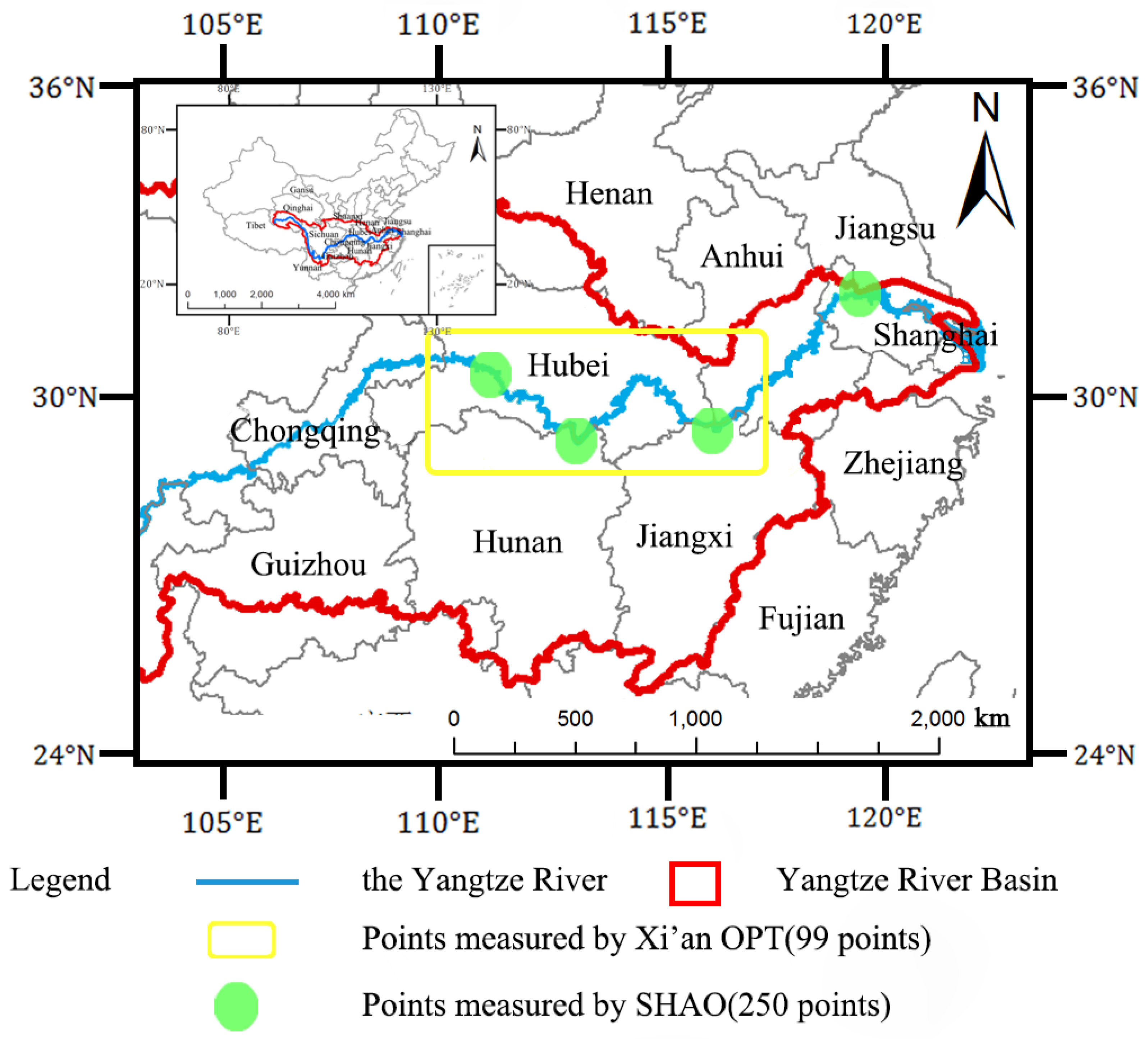

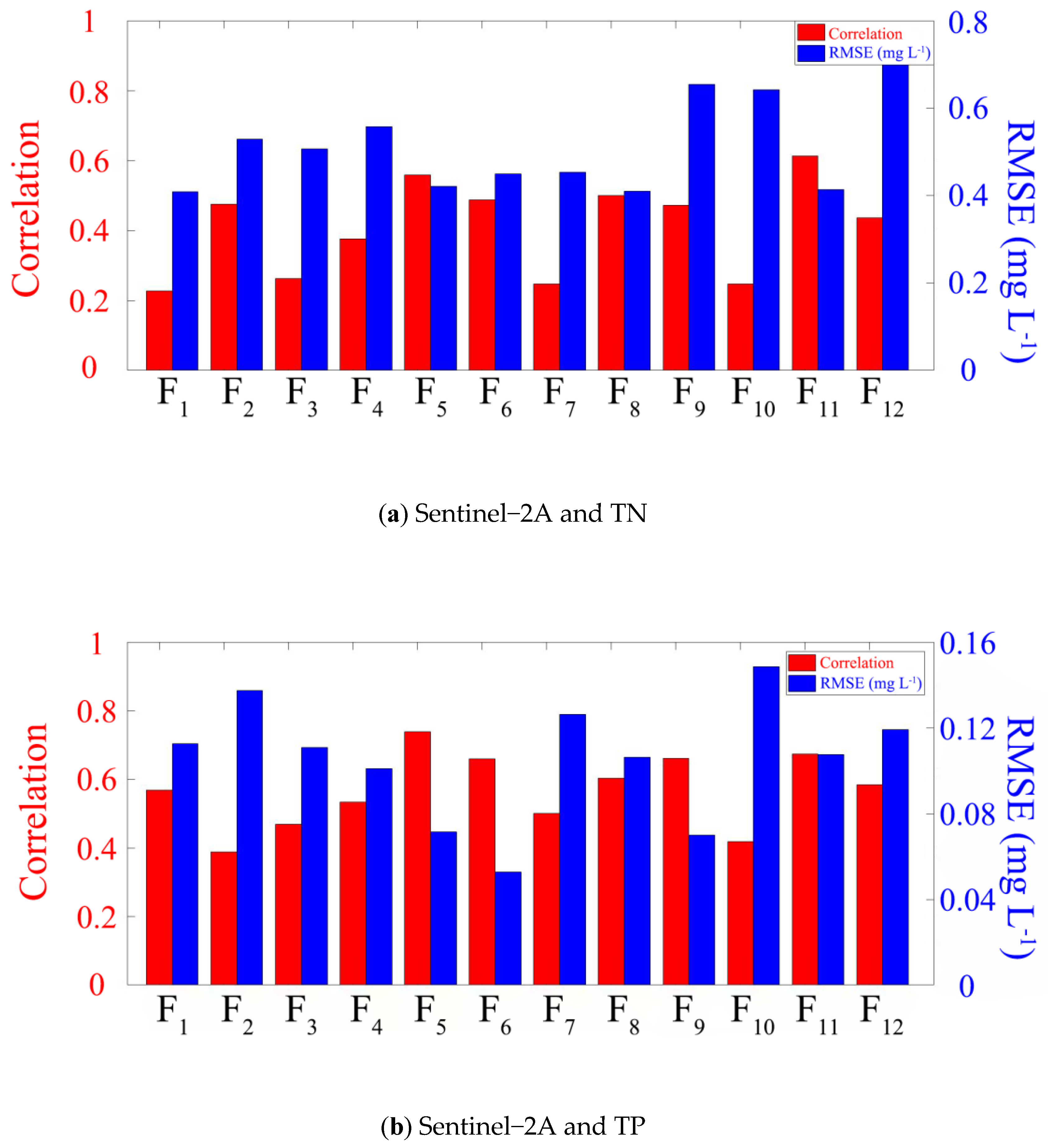
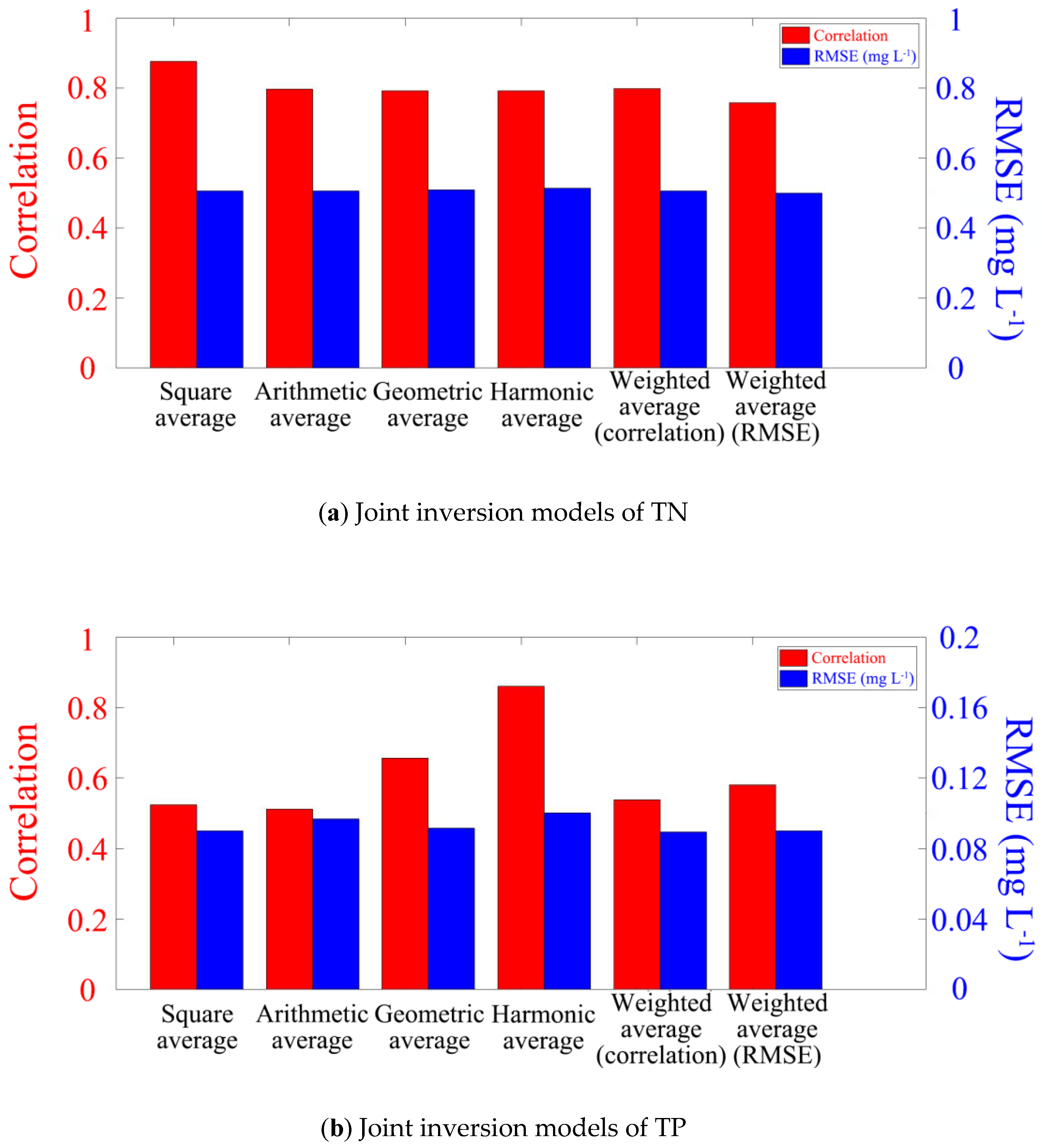

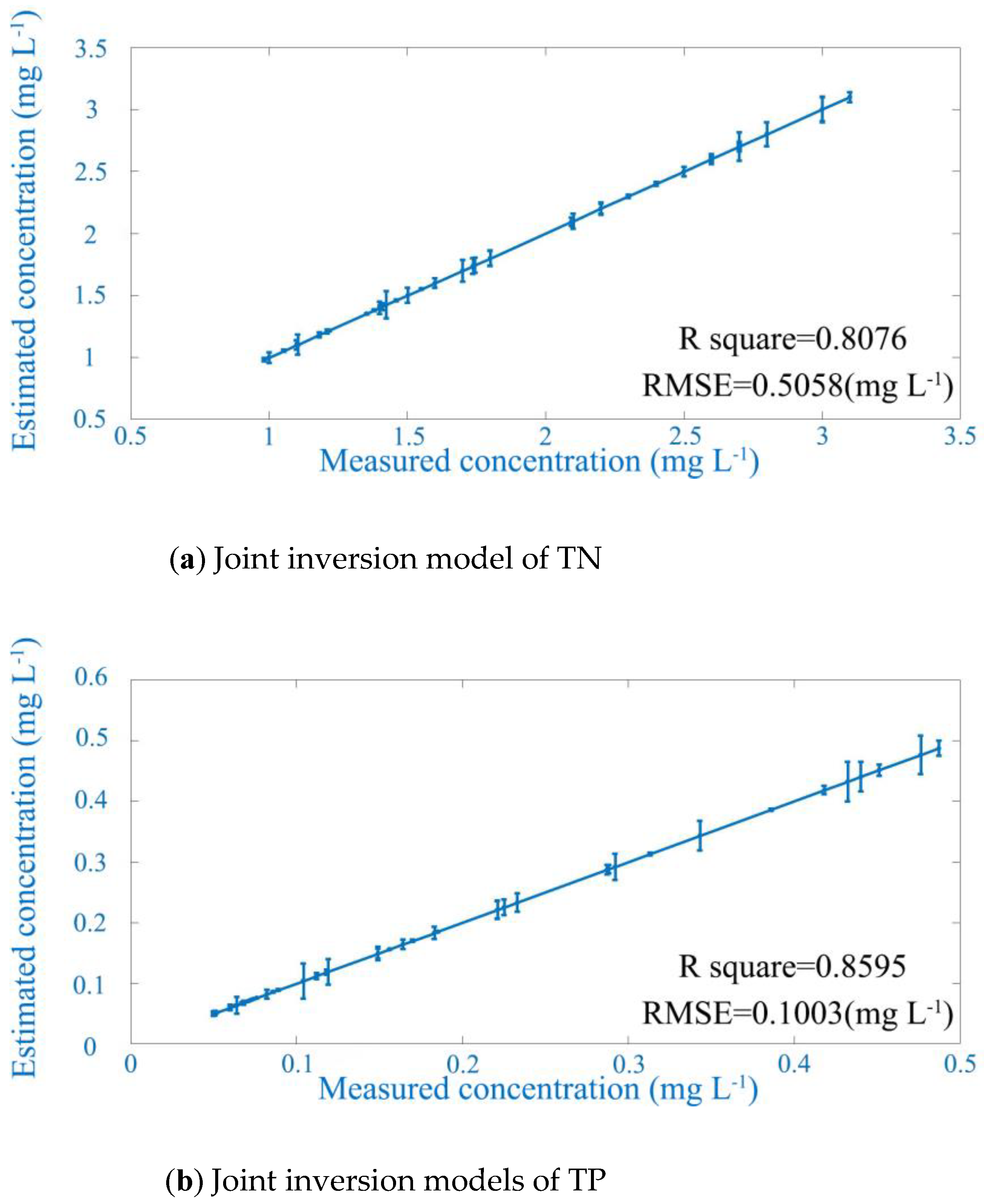


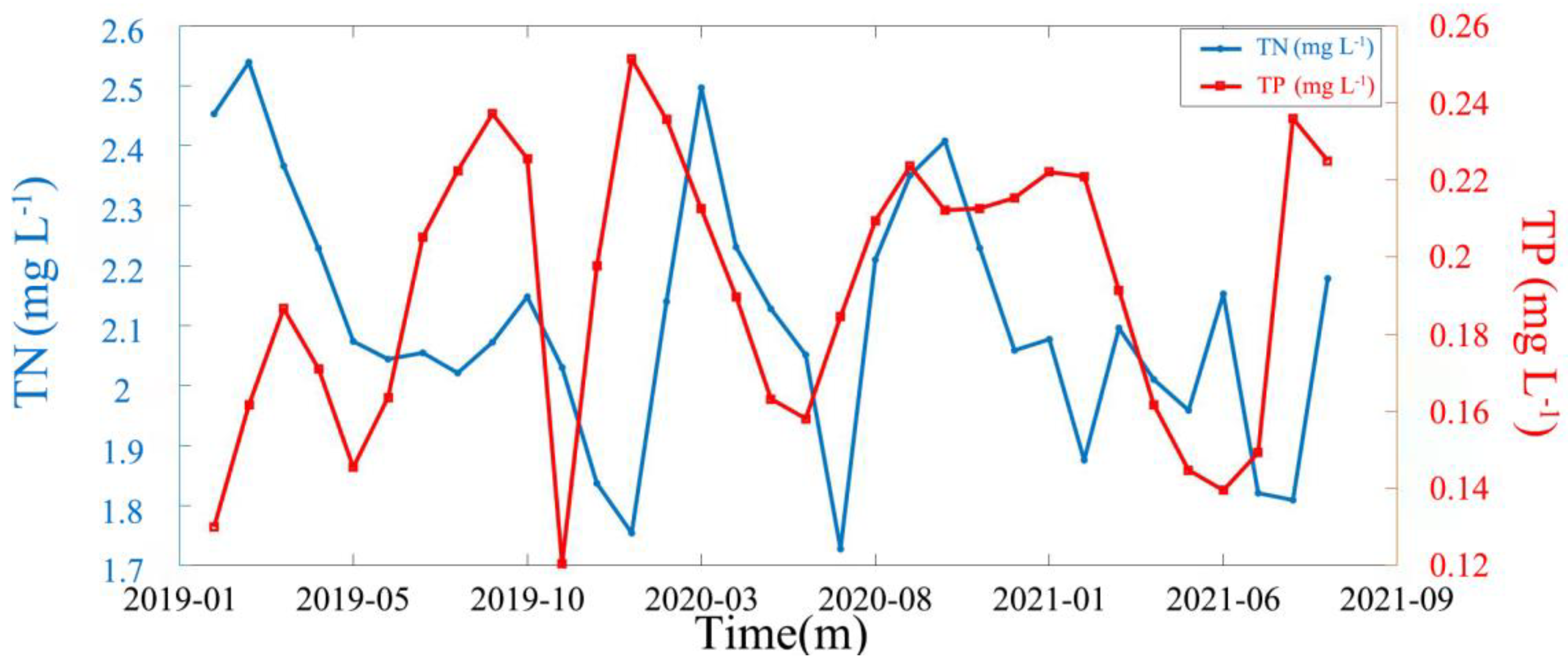


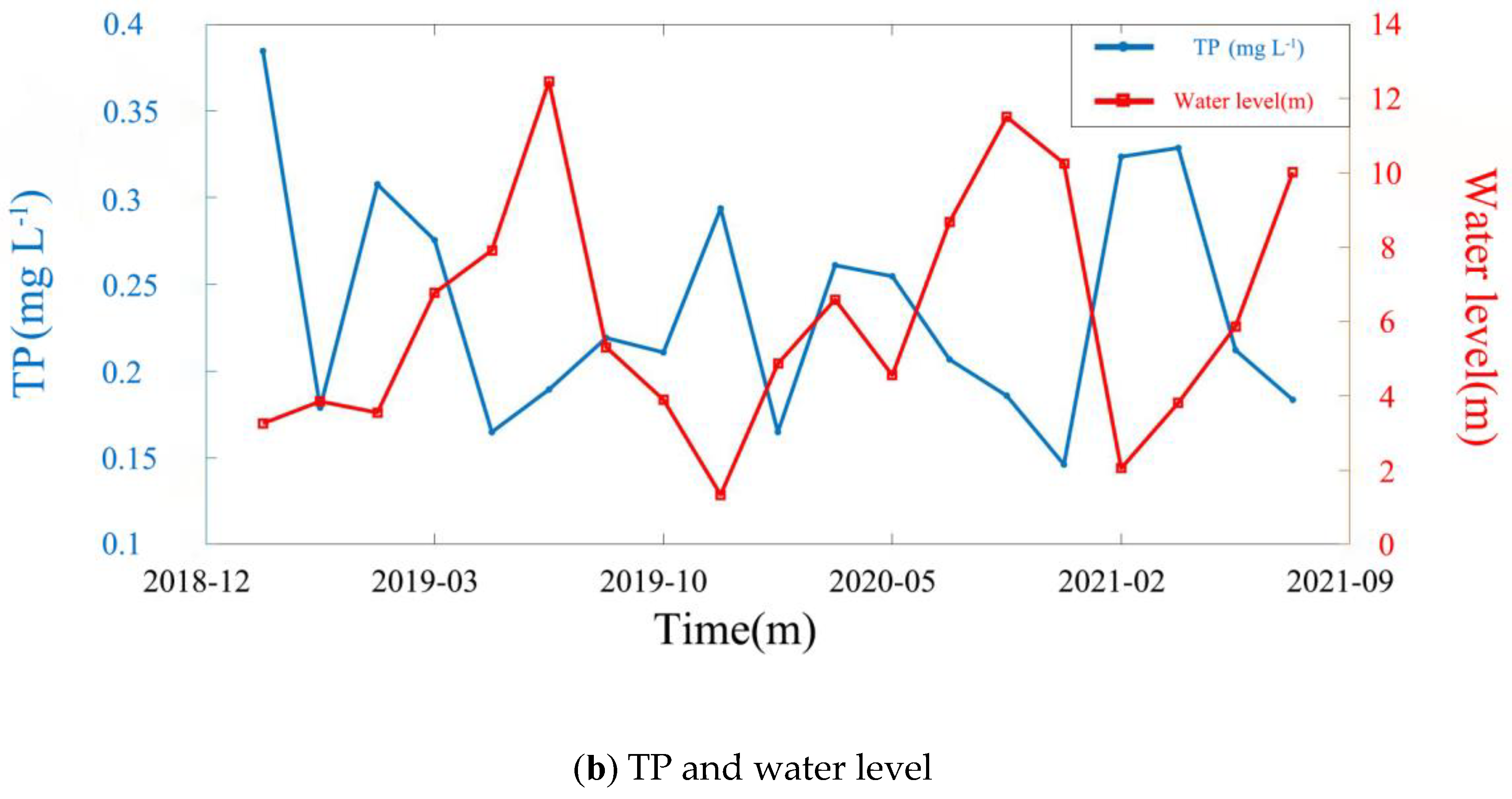

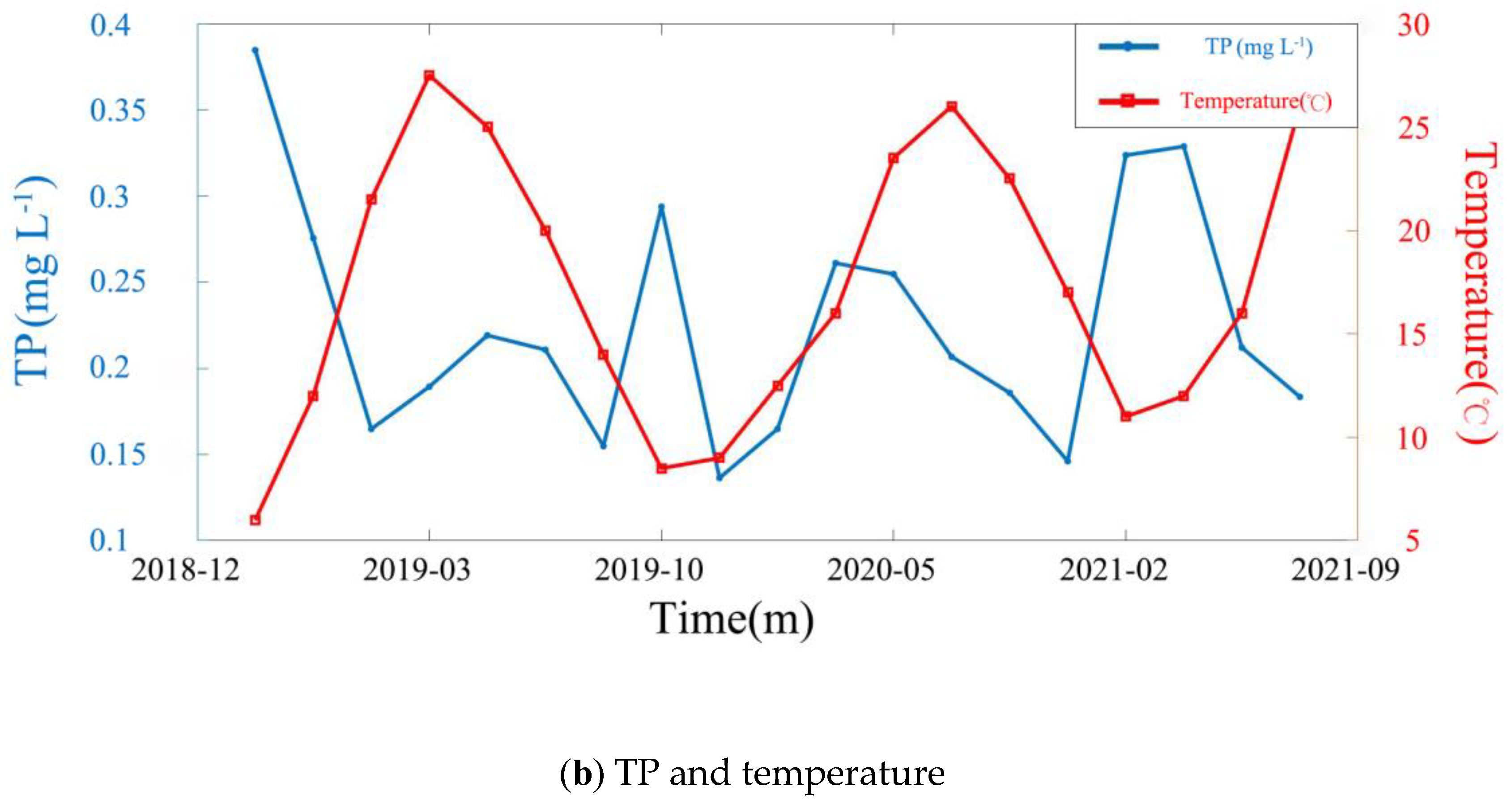
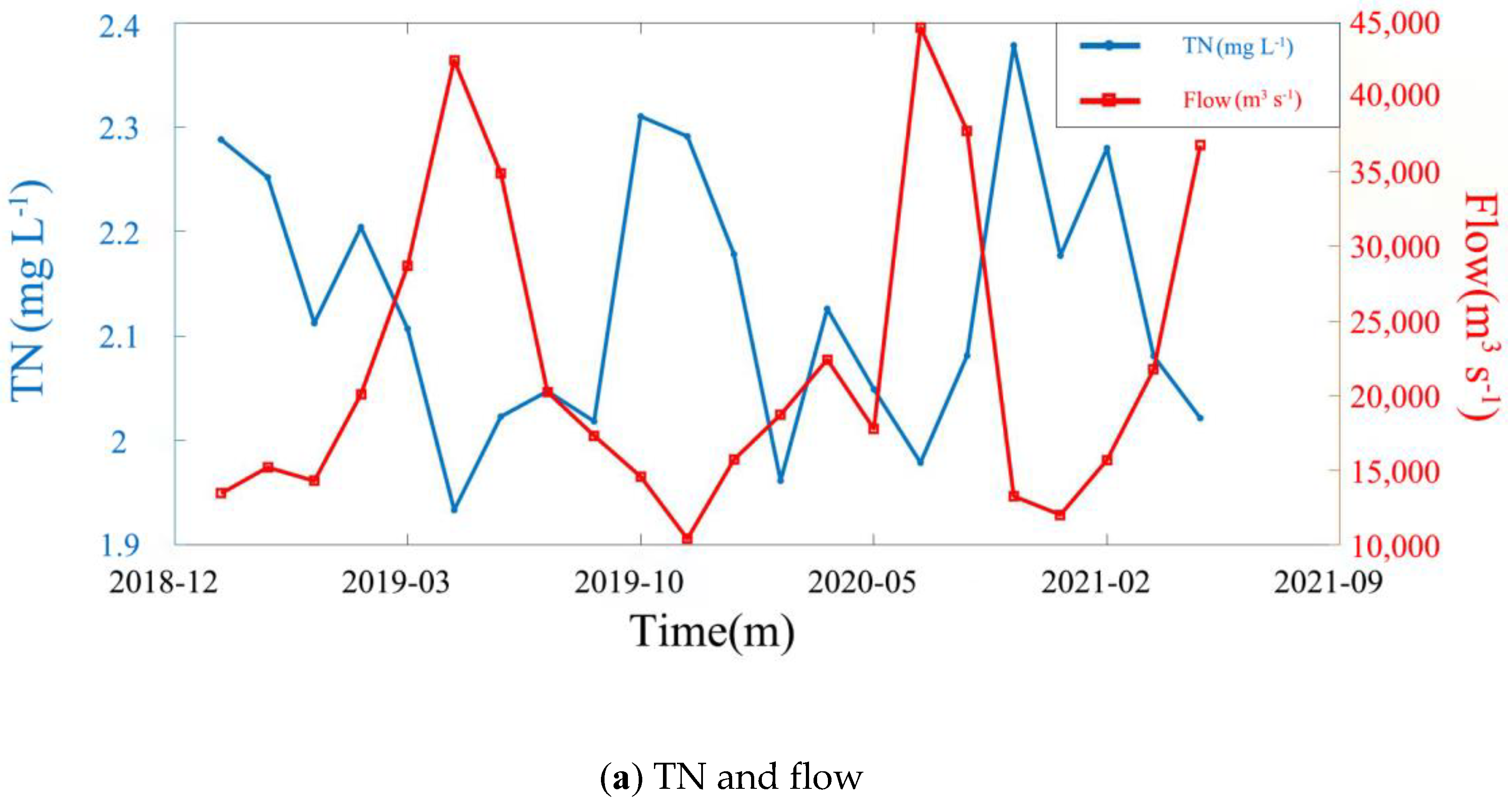

| Band | Wavelength (μm) | Size (m) |
|---|---|---|
| 0.435–0.451 | 30 | |
| (Blue) | 0.452–0.512 | 30 |
| 0.533–0.590 | 30 | |
| 0.636–0.673 | 30 | |
| 0.851–0.879 | 30 | |
| 1.566–1.651 | 30 | |
| 2.107–2.294 | 30 |
| Band | Wavelength (μm) | Size (m) |
|---|---|---|
| 0.4439 | 60 | |
| 0.4966 | 10 | |
| 0.5600 | 10 | |
| 0.6645 | 10 | |
| 0.7039 | 20 | |
| 0.7402 | 20 | |
| 0.7825 | 20 | |
| 0.8351 | 10 | |
| 0.8648 | 20 | |
| 0.9450 | 60 | |
| 1.6137 | 20 | |
| 2.2024 | 20 |
| Satellites | Water Quality Parameters | Characteristics | Inversion Models | RMSE (mg L−1) | |
|---|---|---|---|---|---|
| Landsat-8 | TN | 0.62 | 0.61 | ||
| TP | 0.59 | 0.12 | |||
| Sentinel-2A | TN | 0.61 | 0.41 | ||
| TP | 0.74 | 0.07 |
| Inversion Models | Validation Group’s RMSE (mg L−1) |
|---|---|
| Landsat-8 about TN | 0.72 |
| Landsat-8 about TP | 0.11 |
| Sentinel-2A about TN | 0.48 |
| Sentinel-2A about TP | 0.12 |
| Water Quality Parameters | Joint Inversion Models | RMSE (mg L−1) | |
|---|---|---|---|
| TN | 0.81 | 0.51 | |
| TP | 0.86 | 0.10 |
| Joint Inversion Models | Validation Group’s RMSE (mg L−1) |
|---|---|
| The joint inversion model of TN | 0.57 |
| The joint inversion model of TP | 0.10 |
| Water Quality Parameters | p Value with Water Level | p Value with Temperature | p Value with Flow |
|---|---|---|---|
| TN | −0.76 | −0.64 | −0.69 |
| TP | −0.649 | −0.46 | −0.60 |
Disclaimer/Publisher’s Note: The statements, opinions and data contained in all publications are solely those of the individual author(s) and contributor(s) and not of MDPI and/or the editor(s). MDPI and/or the editor(s) disclaim responsibility for any injury to people or property resulting from any ideas, methods, instructions or products referred to in the content. |
© 2023 by the authors. Licensee MDPI, Basel, Switzerland. This article is an open access article distributed under the terms and conditions of the Creative Commons Attribution (CC BY) license (https://creativecommons.org/licenses/by/4.0/).
Share and Cite
Zhao, J.; Jin, S.; Zhang, Y. Dynamic Water Quality Changes in the Main Stream of the Yangtze River from Multi-Source Remote Sensing Data. Remote Sens. 2023, 15, 2526. https://doi.org/10.3390/rs15102526
Zhao J, Jin S, Zhang Y. Dynamic Water Quality Changes in the Main Stream of the Yangtze River from Multi-Source Remote Sensing Data. Remote Sensing. 2023; 15(10):2526. https://doi.org/10.3390/rs15102526
Chicago/Turabian StyleZhao, Jiarui, Shuanggen Jin, and Yuanyuan Zhang. 2023. "Dynamic Water Quality Changes in the Main Stream of the Yangtze River from Multi-Source Remote Sensing Data" Remote Sensing 15, no. 10: 2526. https://doi.org/10.3390/rs15102526
APA StyleZhao, J., Jin, S., & Zhang, Y. (2023). Dynamic Water Quality Changes in the Main Stream of the Yangtze River from Multi-Source Remote Sensing Data. Remote Sensing, 15(10), 2526. https://doi.org/10.3390/rs15102526







